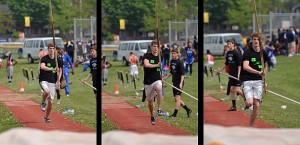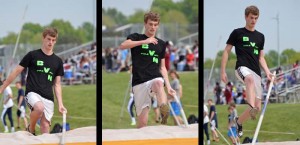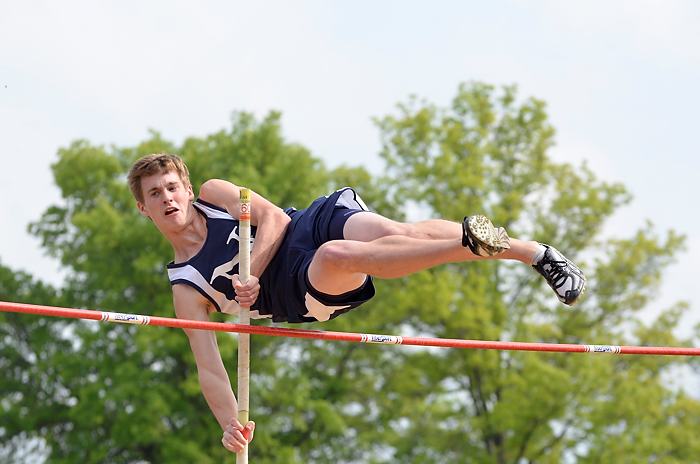Recently I went to one of my nephew’s track meets to shoot some photos of him competing in pole vault. Not only did that give me a chance to get some nice photos of Jeffrey, but it let me work on some good/bad examples of different photo techniques. And that, of course, led me to write this blog post.
People often think frame rate (fps – frames per second) is the most important factor in sports photography. Not true. Learning to time when you shoot is more important, because even at 10 frames per second, you can miss the key moment if you just press and shoot. Try shooting a major league batter swinging at a fastball. Timing is what gets the ball in the photo, not frame rate.
 Focus in the big issue. Unless you’re amazingly good at manual focus, or more importantly, follow-focus, then your sports pictures will live and die by autofocus. And unless you’ve got a good AF system in your camera, they will more often die. To me, that’s one of the major advantages of buying a more expensive camera – the autofocus system. Entry-level cameras will usually have fewer than 10 focus sensors (those rectangles or dots you see in your viewfinder). Which are fine for casual weekend or vacation pictures. Top-of-the-line cameras today have over fifty. Fifty! And all AF sensors aren’t equal. The better ones are called “cross-type,” and are more sensitive (and more expensive). Not surprisingly, more expensive cameras have more cross-type sensors. Those and the camera’s more expensive AF system will give you more extensive controls for how you use AF, which become very important when shooting sports.
Focus in the big issue. Unless you’re amazingly good at manual focus, or more importantly, follow-focus, then your sports pictures will live and die by autofocus. And unless you’ve got a good AF system in your camera, they will more often die. To me, that’s one of the major advantages of buying a more expensive camera – the autofocus system. Entry-level cameras will usually have fewer than 10 focus sensors (those rectangles or dots you see in your viewfinder). Which are fine for casual weekend or vacation pictures. Top-of-the-line cameras today have over fifty. Fifty! And all AF sensors aren’t equal. The better ones are called “cross-type,” and are more sensitive (and more expensive). Not surprisingly, more expensive cameras have more cross-type sensors. Those and the camera’s more expensive AF system will give you more extensive controls for how you use AF, which become very important when shooting sports.
 So how do you use those controls? First you want to make sure you have the camera’s AF system set to “Continuous,” (or “AI Servo” in Canon speak). That means the camera’s expecting the subject to move, and is ready to adjust to try to maintain focus on it. Most DSLRs today offer an “Auto” AF mode, where the camera will try to decide for you whether to lock on a subject or follow focus, but call me old-fashioned – if I’m shooting action, I know I’m always going to want Continuous, so I just set it there.
So how do you use those controls? First you want to make sure you have the camera’s AF system set to “Continuous,” (or “AI Servo” in Canon speak). That means the camera’s expecting the subject to move, and is ready to adjust to try to maintain focus on it. Most DSLRs today offer an “Auto” AF mode, where the camera will try to decide for you whether to lock on a subject or follow focus, but call me old-fashioned – if I’m shooting action, I know I’m always going to want Continuous, so I just set it there.
 Then you need to consider how many points you want to use. More advanced cameras allow you to choose not just one point or all points, but some subset. For instance, the Nikon D7000 that I used to photograph Jeffrey lets me select one, nine, twenty-one or all thirty-nine points. And as long as I’ve set the camera to Continuous, any time I’ve set it for more than one point, it’s using something called “Dynamic-area AF.” That means it starts with the one point you’ve chosen, but if the subject suddenly moves from that point, it will look at those surrounding points (remember, 9, 21 or 39?) to see if it’s there. If it is, it will seamlessly continue to follow focus. Dynamic is way cool, to use a technical term, and other manufacturers tend to have something similar. Check your manual.
Then you need to consider how many points you want to use. More advanced cameras allow you to choose not just one point or all points, but some subset. For instance, the Nikon D7000 that I used to photograph Jeffrey lets me select one, nine, twenty-one or all thirty-nine points. And as long as I’ve set the camera to Continuous, any time I’ve set it for more than one point, it’s using something called “Dynamic-area AF.” That means it starts with the one point you’ve chosen, but if the subject suddenly moves from that point, it will look at those surrounding points (remember, 9, 21 or 39?) to see if it’s there. If it is, it will seamlessly continue to follow focus. Dynamic is way cool, to use a technical term, and other manufacturers tend to have something similar. Check your manual.
Sometimes it’s possible to cheat your autofocus. And cheating can be good. The more action is has to track, the more likely it may miss, especially with a less expensive camera. So if you know the spot where the key action will happen, simply pre-focus there and wait for it. I like using the AF-L (autofocus lock) button for that. When I press and hold it in, the focus can’t move – it’s locked at that distance.
Lenses are also a key part of good autofocus performance. The more light you’ve got, the easier it is for the camera to focus. “Faster” lenses (with wide maximum apertures, like F/2.8 and lower) will help the AF system focus faster because they let more light in. And don’t forget that the same manufacturer may make lenses with newer AF systems. As a Nikon user, I want an AF-S lens if I’m shooting action, because that’s the current top-of-the-line lens as far as autofocus performance goes.
Finally, there’s one more thing that’s very important to remember. No autofocus system, no camera, no lens, will get every picture in focus. Money can solve a lot of problems in photography, but even the most expensive gear still misses at times. And I don’t think that’s a bad thing. After all, where would the thrill be in getting the shot, if you always got the shot?

